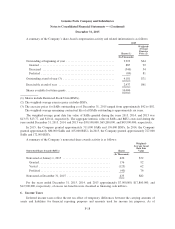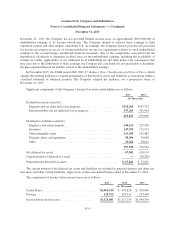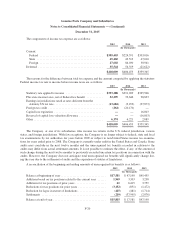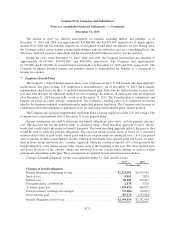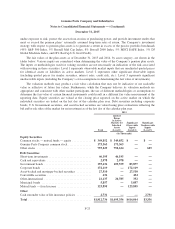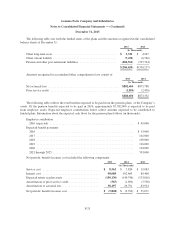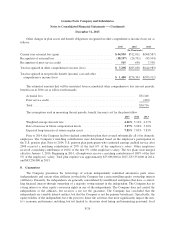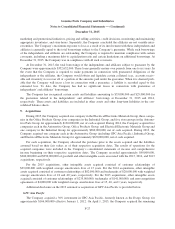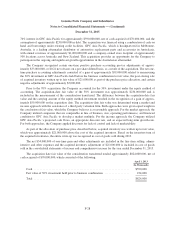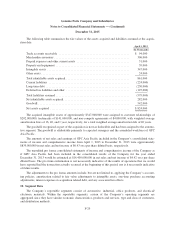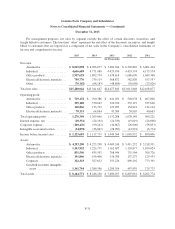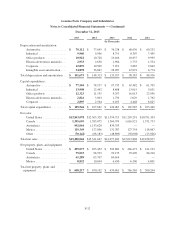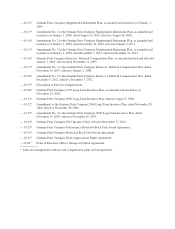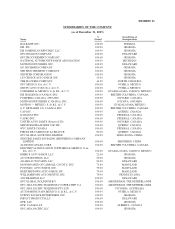Napa Auto Parts 2015 Annual Report Download - page 69
Download and view the complete annual report
Please find page 69 of the 2015 Napa Auto Parts annual report below. You can navigate through the pages in the report by either clicking on the pages listed below, or by using the keyword search tool below to find specific information within the annual report.
Genuine Parts Company and Subsidiaries
Notes to Consolidated Financial Statements — (Continued)
December 31, 2015
Other changes in plan assets and benefit obligations recognized in other comprehensive income (loss) are as
follows:
2015 2014 2013
(In Thousands)
Current year actuarial loss (gain) ................................... $ 44,930 $312,011 $(368,587)
Recognition of actuarial loss ....................................... (38,197) (26,791) (83,934)
Recognition of prior service credit .................................. 565 638 7,538
Total recognized in other comprehensive income (loss) .................. $ 7,298 $285,858 $(444,983)
Total recognized in net periodic benefit (income) cost and other
comprehensive income (loss) .................................... $ 1,450 $276,303 $(393,912)
The estimated amounts that will be amortized from accumulated other comprehensive loss into net periodic
benefit cost in 2016 are as follows in thousands:
Actuarial loss .............................................................. $31,146
Prior service credit .......................................................... (430)
Total ..................................................................... $30,716
The assumptions used in measuring the net periodic benefit (income) cost for the plans follow:
2015 2014 2013
Weighted average discount rate ...................................... 4.26% 5.10% 4.17%
Rate of increase in future compensation levels .......................... 3.07% 3.04% 3.30%
Expected long-term rate of return on plan assets ......................... 7.85% 7.85% 7.83%
Prior to 2014, the Company had two defined contribution plans that covered substantially all of its domestic
employees. The Company’s matching contributions were determined based on the employee’s participation in
the U.S. pension plan. Prior to 2014, U.S. pension plan participants who continued earning credited service after
2008 received a matching contribution of 20% of the first 6% of the employee’s salary. Other employees
received a matching contribution of 100% of the first 5% of the employee’s salary. The two plans were merged
effective January 1, 2014. Beginning in 2014, all employees receive a matching contribution of 100% of the first
5% of the employees’ salary. Total plan expense was approximately $55,066,000 in 2015, $53,351,000 in 2014,
and $43,236,000 in 2013.
8. Guarantees
The Company guarantees the borrowings of certain independently controlled automotive parts stores
(independents) and certain other affiliates in which the Company has a noncontrolling equity ownership interest
(affiliates). Presently, the independents are generally consolidated by unaffiliated enterprises that have a control-
ling financial interest through ownership of a majority voting interest in the independent. The Company has no
voting interest or other equity conversion rights in any of the independents. The Company does not control the
independents or the affiliates, but receives a fee for the guarantee. The Company has concluded that the
independents are variable interest entities, but that the Company is not the primary beneficiary. Specifically, the
equity holders of the independents have the power to direct the activities that most significantly impact the enti-
ty’s economic performance including, but not limited to, decisions about hiring and terminating personnel, local
F-26




